Structure of achievement motive in art students
Aннотация
Introduction. Research into achievement motives and its structure is significant in many areas, such as: selection and development of personnel, university and school education, advisory and pedagogical work with children and students, sports psychology, etc. In addition to theoretical significance, these studies also have practical significance in improving the motivation and efficiency of individuals and groups. Despite the numerous researches on achievement motives, there are few that deal with the artistic population. In our research we will investigate the expressiveness of four standard components of the achievement motive among art students. The intention is to determine whether there are differences in the components of achievement motives among students of different artistic fields. Materials and methods. 100 students from art academies (painting, sculpture, design and acting) participated in the research. The MOP2002 scale was used to examine the achievement motive, which, in addition to the intensity of the achievement motive, also measures the following components: competition with others, perseverance in achieving goals, achieving goals as a source of satisfaction and orientation towards planning. Results. The results show that artistic groups differ both in terms of expression and influence of achievement components. The achievement motive is the most pronounced among acting students, and the least among sculpture students. Also, the groups differ most on the components of achieving goals as a source of satisfaction and persistence in achieving goals. The influence of the competitiveness component proved to be weakly expressed in the decision to engage in art.
Introduction. The achievement motive is one of the most significant and most frequently researched social motives in psychology. According to the opinion of many authors, it is one of the main driving forces of personality. It is especially important for understanding human behavior in those activities and activities that are characterized by: expressed intention to achieve a certain goal and overcome obstacles, additional investment of effort, great perseverance, intention to reach high standards, great desire to succeed, competition with others and/or with himself, the intention to stand out with his achievements in front of himself, but also in front of others. Research shows that people with a pronounced achievement motive prefer occupations that offer challenges, require taking personal responsibility, and provide quick feedback on achievement (Jenkins, 1987; by Reeve, 2018). Also, they show that high valuing of achievement in a certain area is a good predictor of persistence in that area (Ethington, 1991).
Depending on the area in which it manifests, specific types of this motive are mentioned in the literature, such as: school achievement, sports achievement, scientific achievement, artistic achievement, cultural achievement, etc. A review of studies shows that researchers have not been equally interested in all types of achievement motives. They mostly explored achieving success in school, sports, and the work environment. In the field of art, research was done on a smaller scale and mostly related to the field of music. The connection between achievement motives and musical interests (Girgin, 2015), achievement motives and personality traits (Kaufman, Agars, Lopez-Wagner, 2008), achievement motives, cognitive learning strategies and musical creativity (Mawang, et al. 2020), achievement motivation and its impact on music students’ performance (Стреначикова, 2020), etc., has been most often investigated. Bearing that in mind, in this paper we investigated the influence of four standard components of the achievement motive among students of fine, applied and dramatic arts.
Factors influencing achievement motivation. According to the opinion of most authors, the motive of achievement is an acquired motive. It is formed under the influence of numerous social factors (family, school, culture, social value system, etc.), but also experiences and personal characteristics of the individual (McClelland et al., 1953; Reeve, 2018). The intensity of the achievement motive can vary in the same person. Therefore, it can be developed to a different degree among members of the same social group, but at the same time there is also an influence of the group on the individual achievement motive. Depending on the degree of development of the achievement motive, people differ in choices, reaction latency, effort, persistence, willingness to take responsibility for possible successful or unsuccessful outcomes (Cooper, 1983). Some have a high level of need, so they try hard to overcome difficulties, others are afraid of failure and do not strive for advancement (Kaufman, Agars, Lopez-Wagner, 2008).
Studies shows that parenting style is an important factor and that it significantly influences the strength of the achievement motive in children. Children who have a more stimulating family environment, who are encouraged to be independent, to strive for autonomy and to rely on their own strengths, who perceive themselves as capable, positively value tasks in which they can achieve a certain achievement, have a more developed achievement motive (Reeve, 2018).
Also, a certain way of working with students at school contributes to the development of this motive. Depending on whether teachers encourage more achievement-oriented goals or goals related to task mastery, the student's attitude towards teaching, choice of learning strategy, readiness for challenges will depend. A strategy of goals aimed at mastery of the task contributes to the adoption of advanced learning strategies, that students enjoy the lessons more and are more attracted to challenges. On the other hand, the strategy of achievement-related goals contributes to students using more superficial learning strategies, fearing challenges and enjoying lessons less. The choice of learning strategy is reflected both in the results that students achieve and in the classroom climate (Ames & Archer, 1988).
When it comes to arts education, research has confirmed that musical interests play a significant role in the motivation for achievement of future music teachers (Girgin, 2015). Since the achievement motive is related to the field in which it is manifested, it is of interest to investigate how this motive is manifested in the field of art.
The structure of achievement motives. The achievement motive represents a complex motivational disposition. According to McClelland (McClelland et al., 1953), one of the first authors who pointed out the importance of this motive, the achievement motive consists of two components: a person's tendency to achieve set goals and the tendency to compete with other people. Franceško, Mihić, and Bala, (Franceško, Mihić, and Bala, 2002) show that the achievement motive is a more complex structure and consists of four components: competition with other people, perseverance in achieving the goal, achieving the goal as a source of satisfaction and orientation towards planning. Two of these components (competition with other people and persistence in goal achievement) correspond to McClelland's components, while the other two components (goal achievement as a source of satisfaction and orientation towards planning) represent instrumental traits, i.e. forms of behavior that a person develops in order to be successful in competition with other people and/or in achieving goals.
Knowing the structure of the motivation for achievement allows us to determine, in addition to the degree of expression of this motivational disposition, the structure - the profile of a person or group on separate components. Differences in the structure of this motive can show us whether a person or group only has a developed desire for achievement or whether a person (group) has the "ability" (capacity) to be successful, which can be important in further work with those groups. For example, a pronounced tendency towards competition and/or goal achievement, without the traits of persistence, perseverance and planning orientation, is very likely to be an obstacle to success. This contradiction in the structure of achievement motives is often accompanied by a loss of self-confidence, inefficiency, but also by negative emotional reactions, such as envy, malice or hatred.
The research objective. Starting from the fact that the achievement motive has not been researched much in the artistic population, and that most of the research was focused on examining differences in relation to sociodemographic characteristics (gender, age, level of education) and/or personality traits, in this paper we were interested in let's examine the motive of achievement in relation to the orientation towards a certain form of artistic expression. In other words, we were interested in determining the degree of expression of this motive, as well as whether differences in artistic commitment contribute to differences in the degree of expression and structure of the achievement motive. Specifically, the goal was to examine whether there are differences between students of fine arts, design and dramatic arts in the degree of expression and structure of achievement motives.
Methodology and methods. Participants. The research was conducted on a sample of 100 respondents - art students, both sexes (female=77.0%; male=23.0%), average age 20 years. The sample included students from two state and one private Academy of Arts in Belgrade and Novi Sad, departments/majors: painting, sculpture, design and acting. Respondents were divided into 4 groups, considering their artistic orientation: painting (N1=30), sculpture (N2=20), design (N3=20) and acting (N4=30).
Instrument. The MOP2002 scale (Franceško, Mihić, & Bala, 2002) was used to measure achievement motives. This standard instrument contains 55 items given in the form of a classic Likert-type scale. It consists of four subscales, each of which measures one component/factor of the general achievement motive. The components/factors measured by the instrument are:
competition with others − the factor is defined by items that indicate an individual's tendency to stand out in front of others and be more successful than others (e.g. “Competition with others is the biggest incentive for me”);
persistence in achieving goals − the factor is defined by items that indicate persistence as a human trait (e.g. “At any cost, I must achieve success in the activities I am engaged in”);
achievement of goals as a source of satisfaction − which consists of items related to the tendency to achieve goals, the achievement of which is actually perceived as a reward (e.g. “Successfully completed work is the greatest reward for me”);
orientation towards planning − it is defined by items that indicate a person's tendency to plan activities, in order to achieve a predetermined goal (e.g. “I plan everything in advance in order to achieve better results”).
Although the instrument was designed for general measurement of achievement levels and is not primarily intended for the field of art education, we applied it to art students in order to gain insight into the peculiarities and differences between groups.
Procedure. The research was conducted during the 2023/2024 academic year at three art academies in Belgrade and Novi Sad. The examination was conducted in groups and lasted up to 20 minutes on average.
Research results and Discussion. Differences between groups of respondents were observed on the achievement motive scale as a whole, and on individual components (factors).
Analysis of the general expressiveness of the achievement motive
Univariate Analysis of Variance shows that the differences between groups, in terms of expression of the achievement motive, are statistically significant: F(3; 96) = 7.167, p = .000. Pairwise Comparisons are given in Table 1.
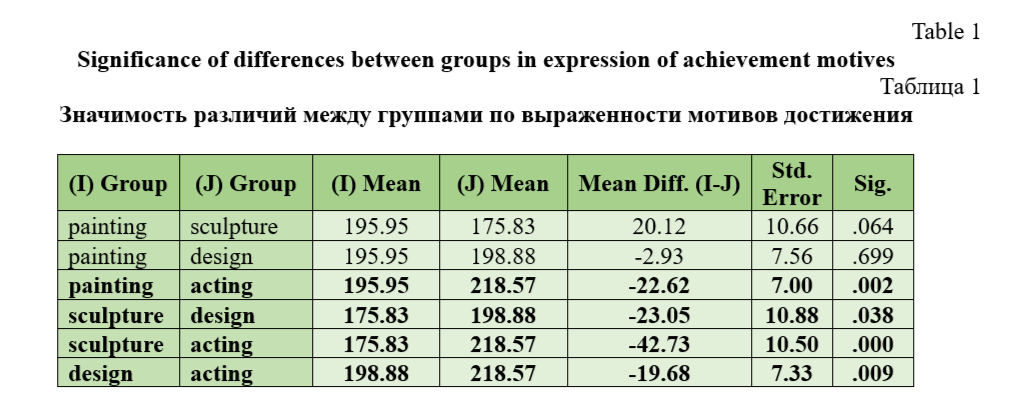 The results show that the general achievement motive is most developed among acting students, less intensive among students of painting and design, and least among students of art (Fig. 1).
The results show that the general achievement motive is most developed among acting students, less intensive among students of painting and design, and least among students of art (Fig. 1).
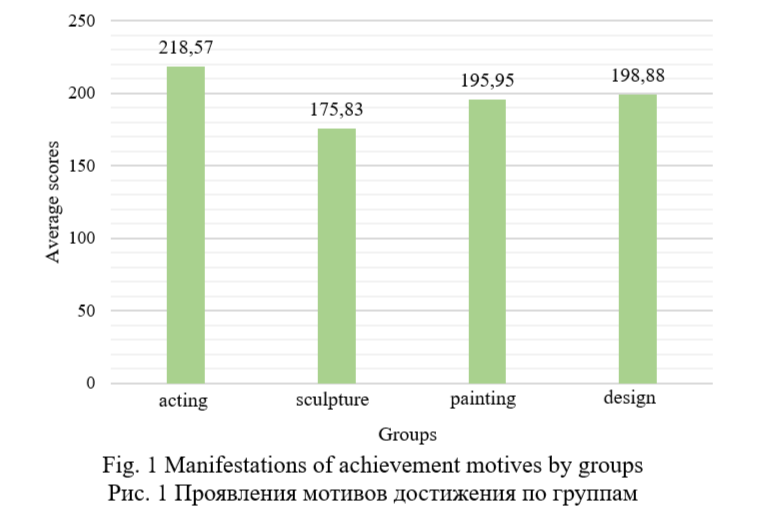
Analysis of achievement motive components. MANOVA was used to examine the significance of differences between groups in the structure of achievement motives. The results show that the Multivariate Tests are statistically significant: F(4;95) = 8.969; p = .000, which means that the groups differ significantly in the components of the achievement motive. Tests of Between-Subjects Effects show that the group effect is statistically significant on component 2 “persistence in achieving goals”: F(3; 96) = 7.823, p = .000; and component 3 “achieving goals as a source of satisfaction”: F(3; 96) = 3.362, p = .024, but not statistically significant on component 1 “competition with others”: F(3; 96)=2.256, p= .090; and component 4 “orientation towards planning”: F(3; 96) = 2.433, p = .073.
Further, Pairwise Comparisons were made for component 2 “persistence in achieving goals” and component 3 “achieving goals as a source of satisfaction” in order to examine the statistical significance of differences between groups for each of the components. The results of the comparison of pairs of groups by components are given in Tables 2 and 3.
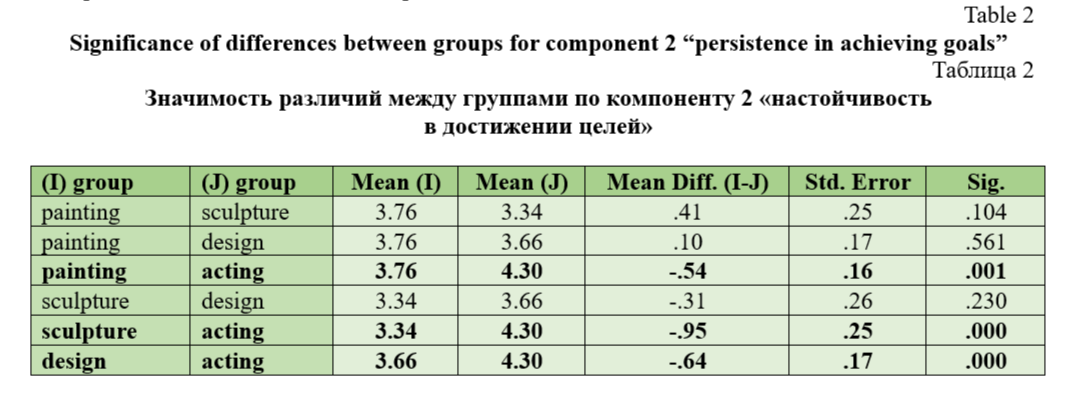 Analysis of the significance of differences between groups for component 2 “persistence in achieving goals” shows that acting students differ significantly in this component from other groups in the sense that they show significantly greater persistence in achieving goals compared to painting students. sculpture and design (Table 2, Fig. 2). In terms of persistence, the commitment to acting sets this group apart from other artistic commitments.
Analysis of the significance of differences between groups for component 2 “persistence in achieving goals” shows that acting students differ significantly in this component from other groups in the sense that they show significantly greater persistence in achieving goals compared to painting students. sculpture and design (Table 2, Fig. 2). In terms of persistence, the commitment to acting sets this group apart from other artistic commitments.
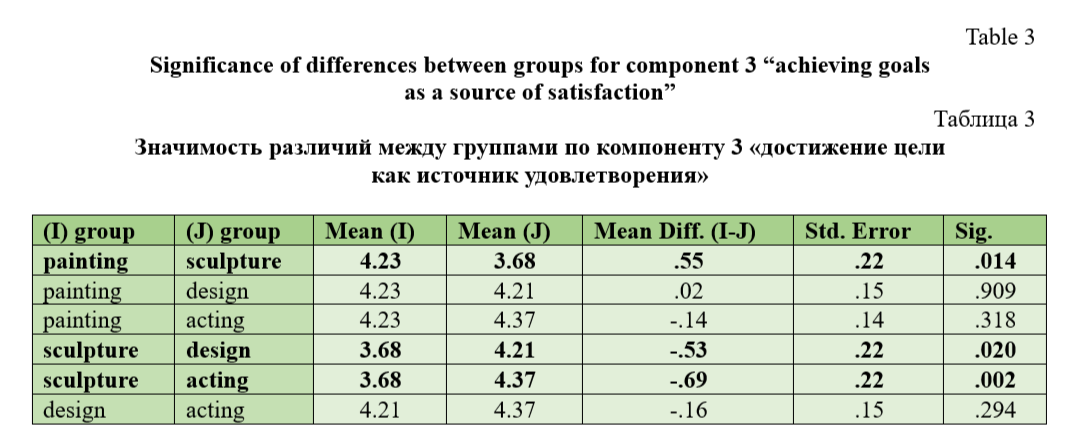 The analysis of the significance of the differences between the groups for component 3 “achieving goals as a source of satisfaction” shows that sculpture students differ significantly in this component from the other groups, in the sense that for them the achievement of goals is a significantly smaller source of satisfaction compared to students of painting, sculpture and design (Table 3, Fig. 2). In terms of satisfaction with achieving goals, sculpture students show significantly less of this component.
The analysis of the significance of the differences between the groups for component 3 “achieving goals as a source of satisfaction” shows that sculpture students differ significantly in this component from the other groups, in the sense that for them the achievement of goals is a significantly smaller source of satisfaction compared to students of painting, sculpture and design (Table 3, Fig. 2). In terms of satisfaction with achieving goals, sculpture students show significantly less of this component.

Analysis of achievement motive profiles by groups. In order to determine the profile of the achievement motive structure among students of painting, sculpture, design and acting, a Paired Samples Test was conducted, which tested the differences between the components for each group individually.
The results show that among painting students, the most developed is the pursuit of goals as a source of satisfaction, followed by perseverance in achieving goals, while competition with others and orientation towards planning are less developed (Table 4, Fig. 2).
 In sculpture students, no single component stands out as dominant, all are expressed to the same degree (Table 5, Fig. 2).
In sculpture students, no single component stands out as dominant, all are expressed to the same degree (Table 5, Fig. 2).
 Among design students, the pursuit of achieving goals stands out as a source of satisfaction, as dominant in relation to other components (Table 6, Fig. 2).
Among design students, the pursuit of achieving goals stands out as a source of satisfaction, as dominant in relation to other components (Table 6, Fig. 2).
 Among acting students, the most developed are the pursuit of goals as a source of satisfaction and perseverance in achieving goals, while the least developed are competition with others and orientation towards planning (Table 7, Fig. 2).
Among acting students, the most developed are the pursuit of goals as a source of satisfaction and perseverance in achieving goals, while the least developed are competition with others and orientation towards planning (Table 7, Fig. 2).

The results of the research show that the expression and structure of achievement motives differ significantly among students of painting, sculpture, design and acting. The findings indicate that the orientation towards a certain form of artistic expression affects the motive of achievement − its expressiveness and structure/profile.
The general measure of achievement is the most pronounced among acting students, which can be explained by the fact that their work is more often exposed to public evaluation, praise, awards, public recognition, but also criticism, than the other examined groups, which contributes to the development of a greater desire for achievement and strengthening of the intention to reach higher standards, but also to prove themselves both to themselves and to others. In addition, the competition among actors is great, and each subsequent engagement depends to a large extent on previous performances and public recognition, much more than in the case of other examined artistic profiles, which contributes to the strengthening of this motive. Acting students not only strive more for achievements, but are also more persistent than others in that intention, which strengthens their predispositions to be successful in that field in the future. In addition, acting as an expression requires the establishment of a social network of relationships through which it manifests itself, the actor acts as part of a wider work, so the ability to engage in this art is much more connected to group work than is the case with fine arts that take place through individual artist’s work with material.
On the other hand, sculpture students have the least developed achievement motive. This can be interpreted by the fact that they perceive the process of artistic creation differently, not as a way to achieve certain goals and be socially visible, not as an opportunity to compete and excel with themselves and in front of others, to achieve great success, but as an intrinsic motivation that is manifested through individual work. Among them, no component of the motive stands out in terms of expression, as in the case of other examined groups. In addition, it is interesting that they differ from students of painting in terms of the expression and structure of this motif, although they belong to the same type of fine arts in terms of orientation and style. This can help define the approach to working with these groups.
The analysis of the structure of achievement motives shows that students of painting, sculpture, design and acting have different profiles, that is, that the expression of individual components depends on the artistic group. The differences are most pronounced in sculpture students, in whose profile there is no single component that stands out in any direction, the presence of the factor shows alignment. The reason for this may be that the given instrument for measuring achievement motives is not sensitive to the intrinsic component of motivation, but rather records the social and extrinsic components of motivation. In this sense, it can be said that although the results are useful and stable, in the field of art they do not really capture the intrinsic components of the motif. From the aspect of Abraham Maslow's hierarchical motivational scheme, we can conclude that the applied instrument, although it provides a useful picture, measures exclusively the area of the affirmation motive, which is the fourth level according to Maslow (Maslow, 1970), and the fifth and highest motivational level - the motive of self-actualization was not covered by this instrument. It is logical to further assume that this fifth level of motivational forces would be of key importance for understanding the motives for practicing art.
The findings show that the biggest differences between the groups are in terms of persistence in achieving goals, as well as the pursuit of goals as a source of satisfaction. Students of acting, painting and design are more persistent in achieving goals, especially if they perceive them as a source of satisfaction, than students of sculpture. On the other hand, achieving a goal as a source of satisfaction is less important for sculpture students. It is obvious that sculpture students differ from the other observed groups and that the motivation for practicing this art is different. It should also be borne in mind that the previous educational context from which the students come most often did not support creativity (Maksić, 2006) or was even negatively correlated with it. In this sense, the educational approach to each particular artistic modality must be set in a specific way that corresponds to that modality.
Conclusion. Implications for the educational process that follow from this research also point to the need to more often use strategies in the educational process that will strengthen intrinsic motivation and rely on the individual capacities of each student. The weak expression of the motive for competition is also an important guide for working with these groups, competitiveness in the way it can be developed in the acquisition of motor, sports or other academic skills, cannot be automatically transferred to work with the mentioned artistic fields. This indicates the assumption that artistic development does not rely on the achievement of the group in relation to which it is measured, but on other, more individual intra-personal factors. Encouraging competition in these areas would have no effect or would perhaps elicit negative motivational responses.
Since this research used a ready-made, pre-standardized motivation test that was made for the general population, we can assume that a more precise and fine recording of motivational factors in art students is needed. In this way, a general picture of the level and some of the components of the motive of affirmation was obtained, but it seems that the motive for art is placed in a much wider and more complex framework. The motivation for art has an emphasized intrinsic component that could not be recorded with the given instrument. However, the results show useful guidelines for working with art students - the motive for practicing acting implies a higher degree of persistence, planning, and task orientation than is the case for practicing fine arts. Also, the competitiveness that appears in many researches of motivation, in the case of commitment to art, does not represent a significant motive, this is probably the reason why visual or acting arts do not rest on a competitive form, nor does competition represent an incentive for engaging in them, unlike music arts where competition is an essential form of work. Another important component of doing art is a high degree of personal involvement, emotionality and motives of exploration, which require a particularly sensitive model of pedagogical work.
Благодарности
This work was supported by the Ministry of Science, Technological Development and Innovation of the Republic of Serbia (Contract No. 451-03-66/2024-03). Prepared as a part of the project “Popularization of science and scientific publications in the sphere of psychology and social policy“, conducted at the University of Niš – Faculty of Philosophy (No. 336/1-6-01).














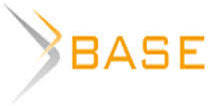


Список литературы
Ames, C. and Archer, J. (1988), “Achievement goals in the classroom: Students' learning strategies and motivation processes”, Journal of Educational Psychology, 80(3), 260-267. https://doi.org/10.1037/0022-0663.80.3.260. (In USA).
Cooper, H.M. (1983), “Teacher expectation effects”, Applied Social Psychology Annual, 4, 247-275. (In USA).
Ethington, C.A. (1991), “A test of a model of achievement behaviors”, American Educational Research Journal, 28(1), 155-172. https://doi.org/10.2307/1162882. (In USA).
Franceško, M., Mihić, V., and Bala, G. (2002), Struktura motiva postignuća merena skalom MOP2002, Ličnost u višekulturnom društvu (Structure of achievement motif as measured by the MOP2002 scale, Personality in a multicultural society). In B. Čukić and M. Franceško (Eds.). Organizacijska multikulturalnost i evropski identitet (Organizational multiculturalism and European identity), (pp. 134-143). Novi Sad: Faculty of Philosophy, Department of Psychology. (In Republic Serbia)
Girgin, D. (2015), “The correlation between the musical interest and achievement motive”, The Anthropologist, 20 (1-2), 33-39. (In India).
Jenkins, S.R. (1987), “Need for achievement and women's careers over 14 years: Evidence for occupational structure effects”, Journal of Personality and Social Psychology, 53(5), 922-932. https://doi.org/10.1037/0022-3514.53.5.922. (In USA).
Kaufman, J.C., Agars, M.D., and Lopez-Wagner, M.C. (2008), “The role of personality and motivation in predicting early college academic success in non-traditional students at a Hispanic-serving institution”, Learning and Individual Differences, 18(4), 492-496. https://doi.org/10.1016/j.lindif.2007.11.004. (In Netherlands).
Maksić, S. (2006), Podsticanje kreativnosti u školi [Stimulating Creativity in School]. Belgrade: Institute for Pedagogical Researches (IPI), Serbia.
Maslow, A. (1970). Motivation and Personality. Addison-Wesly EP Inc.
Mawang, L.L., Kigen, E.M., and Mutweleli, S.M. (2020), “Achievement goal motivation and cognitive strategies as predictors of musical creativity among secondary school music students”, Psychology of Music, 48(3), 421-433. https://doi.org/10.1177/0305735618805837 (In UK).
McClelland, D.C., Atkinson, J.W., Clark, R.A. and Lewell, E.L. (1953), The Achievement Motive, New York: Appleton-Century-Crofts, (In USA).
Reeve, J. (2018). Understanding motivation and emotion. 7th edition, John Wiley & Sons.
Strenachikova, М. (2020), “Achievement motivation and its impact on music students’ performance and practice in tertiary level education”, Music Scholarship, (2), 143-155. (In Russian).